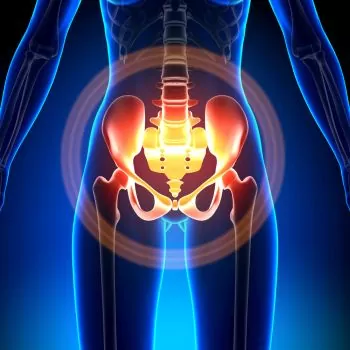
Hi everyone! Today’s article is just for the ladies, sorry guys.
Ladies, are you suffering from prolapse? Whether it’s your uterus, bladder, bowel, or another internal organ, prolapse stinks! (Well, not literally, but you get my meaning.)
If you’re into rowing machines, you’ll definitely want to know how your workouts can affect your pelvic floor and/or prolapse.
Whether you’re new to rowing or you’ve been using a rowing machine, you might be wondering if it is safe to return to rowing. I’ve found that the problem with this issue is that you hear so many conflicting stories.
One friend told me that her doctor warned her NOT to exercise except for walking or swimming until she had surgery. Another friend said that her pelvic floor physiotherapist told her that rowing was one of the best machines she could use.
Now everyone is different and perhaps both stories are accurate and necessary, but how are you supposed to figure all this out?
First off, let me say that I am not a doctor, I’m not even a nurse, so this article should NOT take the place of medical advice. Always speak to your doctor if you have questions.
That being said, I’ve had lots of friends over the years with prolapse or even just pelvic floor issues. If you’ve ever peed yourself just by sneezing or laughing, you have pelvic floor issues.
So in today’s article, I wanted to address this extremely common but little talked-about subject.
Is Rowing Bad for Your Pelvic Floor?
The short and sweet version here is NO!
Rowing is a low-impact exercise because you use a rowing machine sitting down. This actually protects your pelvic floor muscles from further damage.

Now, this doesn’t mean that you can row or use other cardio machines and have poor posture or poor form. Using your rowing machine and having poor form (learn more about correct rowing machine form here) causes you to not engage your abdominal muscles, which puts more strain on your pelvic organs, making prolapse worse.
Read Our Full Review on the Hydrow Interactive Rower!
Can I Modify My Rowing Technique to Protect My Pelvic Floor?
Yes, you certainly can.
If you are experiencing pelvic organ prolapse and whether you’re trying to improve your pelvic floor muscles via exercise or awaiting surgery, you can still use your rowing machine.
The only changes you would make to your form would be to not lean back on the finish stroke and not lean forward on the catch. Keep your back straight and use your abdominal muscles to hold your torso in place.
This will prevent you from adding pressure to your pelvic floor and help strengthen your core muscles and pelvic muscles.
There’s a terrific video by a physical therapist who shows you exactly how to do this. (Don’t you just love her accent, by the way?
What Types of Gym Equipment Are Good for the Pelvic Floor?
Anything that you can sit on is probably a good choice when you have pelvic organ prolapse.
This means that a stationary bike, recumbent bike, rowing machine, and seated ellipticals are all safe bets.
You can also go swimming, which is a fun and terrific low-impact exercise.
Avoid high-impact exercises and most weight lifting. Any weight lifting or weight training that involves your legs is a big NO-NO! I wouldn’t even suggest doing arm weights unless your doctor has given you the OK.
Ellipticals are probably OK as long as you keep the resistance level low and practice good posture. Watch your back and keep it nice and straight. An easy way to do this is to keep your chest up as if you were trying to make your boobs look a bit perkier.
You can also use the treadmill for walking, but again, at the risk of sounding like your mother, you should watch your posture. Most gyms have mirrors, and if you can, choose a treadmill next to the mirror so you can watch your posture.
I don’t recommend any other type of leg raises, push-ups, overhead presses, or other types of exercises unless you have cleared it with your doctor first.
What Exercises Will Make Prolapse Worse?
As you might have gathered from the section above, anything that might put a strain on your pelvic floor will make prolapse worse.

This means that you should avoid:
- Anything that causes you to jump. Obviously, this means jumping rope is out, but this would also include running, calisthenics like jumping jacks, jumping on boxes, and trampolines.
- High-impact aerobic exercise. Low impact exercises, such as walking or using a rowing machine, are fine but high-impact aerobics, tennis, skiing, rugby, squats, lunges, and gymnastics are out.
- Lifting heavy weights. I’ve seen lots of people recommend that weights are OK if they don’t exceed 10 pounds, or if you do them slowly, but in all honesty, I’ve never heard of a doctor or physical therapist say that any size weight was OK. Just avoid them unless your doctor gives you the approval.
- Most yoga workouts. While you might be able to modify some of them, many yoga workouts are pretty intensive. Avoid these unless you get your doctor’s approval.
Chances are that if you have prolapse, your doctor will refer you to a physical therapist or even a pelvic floor physiotherapist. They should give you some pelvic floor exercises and abdominal exercises to help you improve your pelvic floor strength.
Losing weight will also help but to do this, you need to exercise.
You can ask your doctor about specific exercises and whether a certain high-impact exercise is OK for your case.
Will Walking Make Prolapse Worse?
The pelvic floor is a big muscle that supports all our internal organs. After giving birth, or even as we age or go through menopause, this muscle can become weaker, and the amount of damage (or weakness) will vary from woman to woman.
Some women say that walking or standing for long periods of time makes their pain, pressure, or discomfort worse. Others say that walking helps them reduce pain.
Speak to your doctor and listen to your body. Make walking a part of your daily routine, but don’t overdo it. Add a few minutes every other week to your walking routine to help improve your stamina and help you reduce body fat.
- Want a Stylish Wooden Rower – Click Here to Read Our Ergatta Rower Review!
Will My Prolapse Improve Without Surgery?
It used to be that women would use pelvic floor exercises to help manage their symptoms until they finally gave in and had prolapse surgery.
While you might find that your symptoms do not completely disappear without prolapse surgery, there are plenty of other options available to women today.

The pelvic floor can be reconstructed via the vagina, requiring no abdominal incision, or you might opt to have laparoscopic surgery.
While you may be able to reduce your symptoms and reduce your overall discomfort, chances are that you will still need to have surgery to completely fix the problem.
This is a matter you should discuss with your doctor in detail.
The Bottom Line
In nearly all cases, using a rowing machine is safe for women with prolapse. Since you are sitting and this is a low-impact exercise, you should have no issue with rowing affecting your pelvic floor as long as you follow the correct technique mentioned above.
I have had many women friends who have used a rowing machine to help improve their overall health, lose weight, and drastically reduce their symptoms.
You should always check with your healthcare professional before trying any new exercise program or continue a rowing workout if you have prolapse.
Remember that what works for one woman may not work for you, so consult with your doctor and keep in mind that your pelvic floor muscles may not heal completely without surgery.
Happy rowing, friend! Stay healthy and safe!
Written by Petra Amara – RowingCrazy.com
CEO & Founder of RowingCrazy, National Rower, Coxswain Womens Eight Team, Rowing Coach & Writer
Petra is a Mother of two and owner of Rowingcrazy.com. Petra lives and breathes rowing, she also has a passion for writing which lead her to start RowingCrazy.com to share her rowing experience and expertise with others.







Pingback: